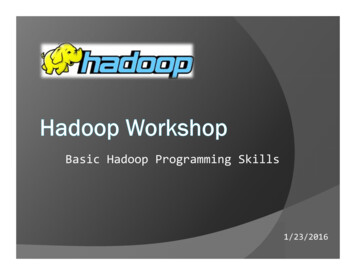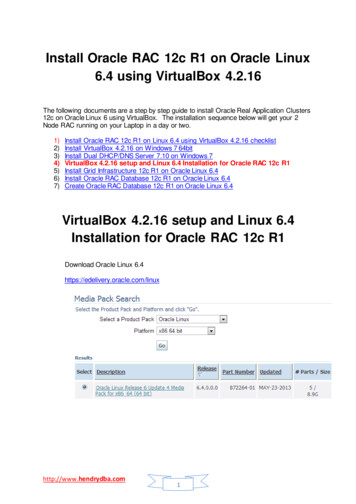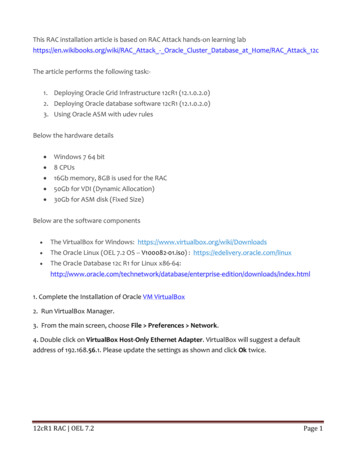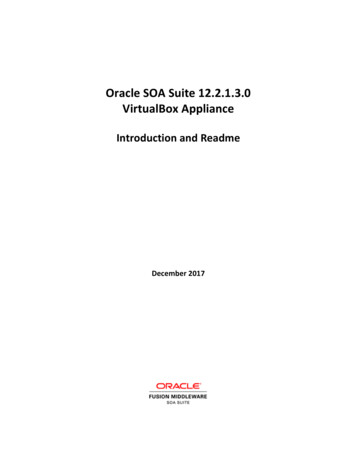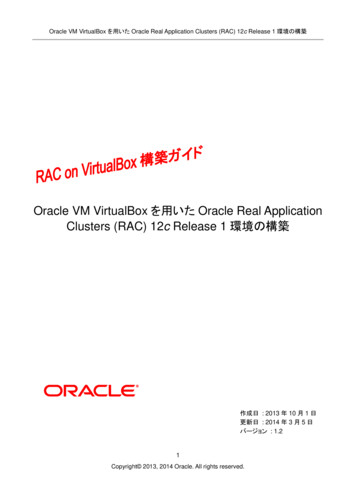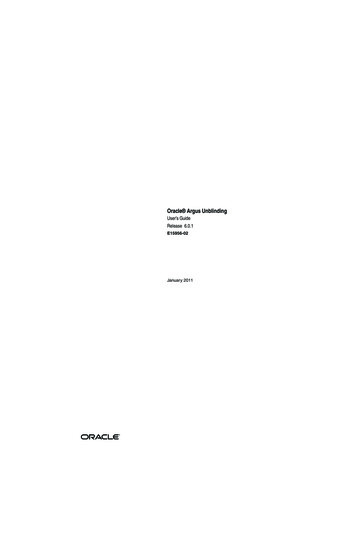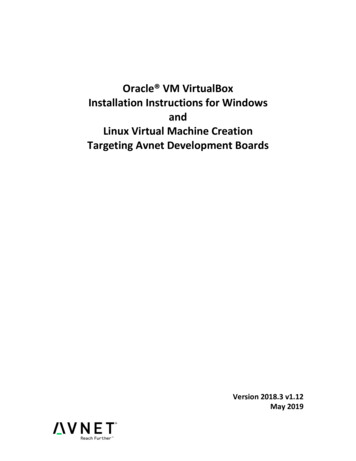
Transcription
Oracle VM VirtualBoxInstallation Instructions for WindowsandLinux Virtual Machine CreationTargeting Avnet Development BoardsVersion 2018.3 v1.12May 2019
Xilinx Vivado /SDK/PetaLinux/SDx 2018.3VirtualBox and VM CreationDownload LinksWhile this document shows how to setup and install a VirtualBox environment for use of a Linux virtualmachine for the cross-build platform, downloads are large. It is recommended to begin all downloadsahead of time to save time later when continuing the instructions in this document. The download linksare also interleaved in the appropriate locations IN this document, however, it is recommended todownload all files early as they can take quite some time.VirtualBox and Extension Pack s1. Platform package for Windows hosts ( 110 MB)2. Extension pack ( 20 MB)Vivado and SDK (NOT needed for Avnet Technical Training igntools.htmlVivado HLx All OS installer single-file download recommended ( 17 GB)or use the Linux self-extracting web installer ( 100 MB), which downloads the rest during installNote that you do not need the Updates unless you need specific support for the devices included in thoseupdates.SDSoC (includes Vivado and ment-environments.htmlSDx SFD download recommended ( 20 GB)or use the Linux 64 web installer ( 100 MB), which downloads the rest during installNote that you will need an SDSoC license. If you only plan on using Vivado and SDK, there is NO need todownload the SDSoC installer. If you are planning to use SDSoC, then it is strongly recommended toinstall the SDSoC installer ONLY, as this will include the Vivado HLS install, SDK, as well as the SDxextensions for the Eclipse environment.The PetaLinux esign-tools.htmlDownload PetaLinux Installer ( 6 GB)Ubuntu ISO:Please refer to the latest copy of UG1144, to identify which revision of Ubuntu is supported. Choose thelatest update for that version, which as of this writing is top-amd64.iso1May 2019
Xilinx Vivado /SDK/PetaLinux/SDx 2018.3VirtualBox and VM CreationWhen complete, you should see something like below, along with either Xilinx Vivado/SDK or SDSoCinstallation archive.2May 2019
Xilinx Vivado /SDK/PetaLinux/SDx 2018.3VirtualBox and VM CreationPreparing Your MachineFor best results with using VirtualBox Virtual Machines (VMs) as depicted in this document, somepreparation of your machine is required to enable virtualization extensions for your CPU within thesystem BIOS (or UEFI) and to make sure that no conflicting virtualization packages are loaded.Enabling CPU Virtualization Features:The system BIOS (or UEFI) of a PC is responsible for enabling virtualization extensions and features ofCPUs that support Virtualization Technology (VT). This is important because workstation anddevelopment workloads can co-locate while maintaining full isolation from each other. They can alsofreely migrate across infrastructures and scale as needed.To enable your CPU virtualization extensions, you will need to reboot your PC and enter the (BIOS orUEFI) configuration menu. This often involved holding down a special key during the early stages ofbooting the PC, so you may need to refer to the manufacturer documentation for your specific model ofPC or motherboard to know which key is needed to enter the configuration screen. Once in theconfiguration screen, look for the Intel VT-x, Intel Virtualization Technology, or VirtualizationExtensions options and make sure that they are enabled. Again, model specific PC manufacturerdocumentation may help here with locating the correct settings.For further information on enabling virtualization features on the CPU of your development machine,there are other resources that provide mware/3May 2019
Xilinx Vivado /SDK/PetaLinux/SDx 2018.3VirtualBox and VM CreationDisabling Windows 10 Hyper-V:Windows 10 Pro includes Microsoft provided VM enablement called Hyper-V. However, Hyper-V andVirtualBox cannot be used concurrently. The Hyper-V feature of Windows needs to be disabled to useVirtualBox. If Hyper-V is enabled VirtualBox may still run to a point and then VM will likely hang withoutany explanation from VirtualBox that Hyper-V is still enabled.If more advanced users want to run Docker for Windows, it will require Hyper-V instead of VirtualBox.The following dialog is where many Windows 10 features can be enabled/disabled, you can find it fromthe Win 10 search bar with the “Windows Features” search string and Hyper-V can be disabled byremoving the checkmarks next to these features:Microsoft has also provided an answer on the topic of disabling Windows 8 and Windows 10 s/forum/windows 8-windows 52-bfe5-ea41e58067ab4May 2019
Xilinx Vivado /SDK/PetaLinux/SDx 2018.3VirtualBox and VM CreationInstalling Oracle VM VirtualBox on WindowsThis document shows how to install VirtualBox and the Extension Pack to enable the use of a Linuxvirtual machine for the cross-build platform.General Instruction:Install Oracle VM VirtualBox using the official VirtualBox installer. For legal distribution reasons, theVirtualBox installation executable cannot be included with any public Avnet materials. To obtain a freelegal copy of the Oracle VM VirtualBox and the Extension Pack, please download from the DownloadsThe version downloaded may differ from the version shown in this documentation (5.2.26). Be sure toread the VirtualBox EULA to ensure you do not violate the Personal Use and Evaluation License (PUEL).You may also wish to consult the VirtualBox Licensing Frequently Asked Questions for a quick overviewof the intent of the license ng FAQStep-by-Step Instructions:1. To obtain a free legal copy of Oracle VM VirtualBox, download the installer from this he version downloaded may differ from the version shown in this documentation (5.2.26). Youalso need to download the Extension Pack which is a separate download. Make sure theExtension Pack you download is the same version as your VirtualBox installer.2. Launch the VirtualBox installer from Windows Explorer by double-clicking the self-extractingexecutable. Allow the installer to make changes to your computer, if so prompted.VirtualBox Installer for Windows5May 2019
Xilinx Vivado /SDK/PetaLinux/SDx 2018.3VirtualBox and VM Creation3. Once the VirtualBox installation wizard appears, click the Next button.4. You may accept all the installation defaults, although you may wish to change the installationlocation on your development platform using the Browse button. If the options are acceptable,click the Next button.6May 2019
Xilinx Vivado /SDK/PetaLinux/SDx 2018.3VirtualBox and VM Creation5. You may again accept the default options and click the Next button.6. Click the Yes button to continue with the installation wizard.7May 2019
Xilinx Vivado /SDK/PetaLinux/SDx 2018.3VirtualBox and VM Creation7. Click the Install button to load VirtualBox to your development system.8. During the installation you may receive prompts to authorize installation of variouscomponents. If prompted, allow the installer to make changes to your system, includinginstallation of the USB interface and Network adapters.8May 2019
Xilinx Vivado /SDK/PetaLinux/SDx 2018.3VirtualBox and VM Creation9. If you are asked to install the Oracle Corporation Universal Serial Bus device driver, or OracleCorporation Network Adapters/Network Service, choose to install them9May 2019
Xilinx Vivado /SDK/PetaLinux/SDx 2018.3VirtualBox and VM Creation10. Click the Finish button to complete the installation. Leave the checkbox enabled so VirtualBoxwill start after the installer finishes.11. Once VirtualBox starts (you can also start it from the Desktop shortcut, or the Windows Startbutton), the Extension Pack must be added. From the main menu, select File Preferences.10May 2019
Xilinx Vivado /SDK/PetaLinux/SDx 2018.3VirtualBox and VM Creation12. Select Extensions. Right-click in the Extension Packages whitespace box and select Add Package.13. Browse to the location where you downloaded the VirtualBox Extension Pack compatible withyour VirtualBox version. Select the Extension Pack and click the Open button.14. Click the Install button to add the VirtualBox Extension Pack.11May 2019
Xilinx Vivado /SDK/PetaLinux/SDx 2018.3VirtualBox and VM Creation15. Read the VirtualBox Extension Pack PUEL License to ensure you will not be in violation of theOracle definition of Personal Use. See the VirtualBox Licensing Frequently Asked Questions foradditional details. If you can accept the license conditions, scroll to the bottom of theagreement text box and click the I Agree button 1. If prompted, allow the installer to makechanges to your development system.16. Click the OK button to complete the installation.1If you must disagree, the installation will be terminated. You should either purchase a commercial license oruninstall VirtualBox from your host computer.12May 2019
Xilinx Vivado /SDK/PetaLinux/SDx 2018.3VirtualBox and VM Creation17. Click the OK button to return to VirtualBox.This completes the installation of VirtualBox on your host development system. VirtualBox is now readyto accept a new Virtual Machine.13May 2019
Xilinx Vivado /SDK/PetaLinux/SDx 2018.3VirtualBox and VM CreationCreate a New Virtual Machine1. Launch Oracle VM VirtualBox Manager and click the New icon at the upper left.2. Select a descriptive name for the VM. Set the Type to Linux and the Version to one thatcorresponds to the OS you wish to install.a. For Ubuntu, choose Ubuntu (64-bit).14May 2019
Xilinx Vivado /SDK/PetaLinux/SDx 2018.3VirtualBox and VM Creation3. Select the amount of memory to be allocated to the Virtual Machine. Allocating more memory 2will improve the VM performance, but you must leave enough memory available for your hostsystem for all other concurrent processes. For a host system with 16 GB of RAM, a value of8192 MB is recommended for the Virtual Machine, especially if you intend on using XilinxSDSoC. You may wish to experiment with this value to optimize your performance as largerdensity target devices have higher2 memory requirements. The memory can also be changed atany time even after installing the VM hosted OS. You will need to locate a balance of host andguest performance through properly balancing this. Of course, the MORE memory you canprovide the guest, WITHOUT causing issues for the host, the better your guest OS will run!4. Click the Create 3 button to accept the default file type for a VirtualBox Disk Image and allocate avirtual hard drive now.23You may need more memory if you intend to run Vivado with large Xilinx devices.If you are importing an existing Virtual Machine, click the “Use an existing ” button.15May 2019
Xilinx Vivado /SDK/PetaLinux/SDx 2018.3VirtualBox and VM Creation5. Select Next, leaving the defaults for Hard disk file type6. Select Fixed Size for the physical storage on your host hard drive. This will improve overallperformance of the Virtual Machine.16May 2019
Xilinx Vivado /SDK/PetaLinux/SDx 2018.3VirtualBox and VM Creation7. Select the name and location for the Virtual Machine within your host file system. Therecommended size is at least 300.00 GB to accommodate the Xilinx tools. If this space isunavailable, 150.0 GB is the very least amount and will require frequent project cleanings tomake room for new projects. Click the Create button.The Virtual Hard Disk may take a few minutes to create and initialize on your host file system.17May 2019
Xilinx Vivado /SDK/PetaLinux/SDx 2018.3VirtualBox and VM Creation8. Once the Virtual Disk completes, select the newly created VM and click on the Settings buttonto open the Settings dialog specific to the VM instance.9. Under the System blade and the Processor tab, select the number of logical CPU cores to beallocated to the Virtual Machine. Allocating more CPU cores will improve the VM performance,but you must leave sufficient CPU cores available for your host system for all other concurrentprocesses. For a host system with 8 CPU cores, a value of 4 CPU cores is recommended for theVirtual Machine, especially if you intend on using Xilinx SDSoC. You may wish to experiment withthis value to optimize your performance as larger density target devices have higher2computation requirements for design placement. The memory can also be changed at any timeeven after installing the VM Guest OS as long as the Guest is shut down and the VM poweredoff. You will need to locate a balance of host and guest performance through properly balancingthis.18May 2019
Xilinx Vivado /SDK/PetaLinux/SDx 2018.3VirtualBox and VM Creation10. Once the processor allocation has been modified in the above step, your VM is ready to acceptan operating system.19May 2019
Xilinx Vivado /SDK/PetaLinux/SDx 2018.3VirtualBox and VM CreationInstall the Ubuntu 16.04 Operating SystemTo perform the steps in this section, you will need to download a bootable OS image in .iso format toyour host system. While Ubuntu 17.04 is the latest, Ubuntu 16.04.2 is the recommended version(ubuntu-16.04.2-desktop-amd64.iso). We have also seen other sub versions of Ubuntu 16.04 work withthis. The Ubuntu images can be downloaded from:http://www.ubuntu.com/download/desktop1. Launch VirtualBox (if necessary) and select the VM you wish to start in the left-hand panel. Clickthe Start button to execute the VM.2. Select the Browseicon to locate the .iso image for the OS you wish to install on your VirtualMachine. Click the Start button to begin.20May 2019
Xilinx Vivado /SDK/PetaLinux/SDx 2018.3VirtualBox and VM Creation3. When the Install Welcome screen appears, select English and click the Install Ubuntu button.4. If at any point you find the display is too small, such that the buttons are outside the field ofview, you can click and drag the window to bring it into view. Although not very visible, there isa banner area immediately to the right of the “Install (as superuser)” text. Click and hold yourmouse in that top banner area and drag the window so the buttons come in view. We will adjustthe display later.5. The installer shows requirements for installation. The two options can be left unchecked. Clickthe Continue button.21May 2019
Xilinx Vivado /SDK/PetaLinux/SDx 2018.3VirtualBox and VM Creation6. The installer displays various installation types. The default displays as Erase disk and installUbuntu. Click the Install Now button.As this is a new installation, we want all changes written to the disks. Click the Continue button.7. Select your time zone and click the Continue button.22May 2019
Xilinx Vivado /SDK/PetaLinux/SDx 2018.3VirtualBox and VM Creation8. Select your preferred keyboard layout option. The default displays as English (US). Click theContinue button.For the purposes of this tutorial, we will use a User ID (uid) of training. This will also set the defaultGroup ID (gid) to training. Feel free to change references to training as the uid or gid to a different nameof your choosing.9. Enter the primary user name for the Virtual Machine in field “Your name” as training. Thesystem will auto-populate the computer name and username. Enter and confirm any passwordof your choosing, but please remember what this is. Click the Continue button.23May 2019
Xilinx Vivado /SDK/PetaLinux/SDx 2018.3VirtualBox and VM Creation10. The installation displays a Welcome graphic and proceeds with installation. When theinstallation is complete, a screen appears asking you to restart. Click the Restart Now button.If the Restart appears to “freeze”, you can force a reboot manually:a. From the main VirtualBox menu, select File Close.b. In the Close Virtual Machine dialog, select Power off the machine and click the OKbutton.c. In the Oracle VM VirtualBox Manager, select your Virtual Machine and click the Startbutton.If Ubuntu requests that you remove the installation media and press enter to continue, it iseasiest to select Devices- Insert Guest Editions CD image 24May 2019
Xilinx Vivado /SDK/PetaLinux/SDx 2018.3VirtualBox and VM CreationConfiguring VirtualBox for Better Ease of UseConfiguring VirtualBox on a supported Linux system should be straightforward but depending on theprecise hardware configuration of your development system, there could be some challenges to createan optimal environment. This section outlines a few of the common issues that may be encounteredalong with some suggested workarounds to help increase the ease of use for the environment.Adjust Display Preference1.2.3.4.Select File PreferencesSelect the Display bladeSet the Maximum Guest Screen Size to Automatic.Click OK.VirtualBox Guest Additions Installation (File Sharing)1. The use of shared folders allows for easy transfer of files between the host and guest systems.To use the shared file facility of VirtualBox, you must install the Guest Additions(VBoxGuestAdditions 5.1.22.iso). If you attempt to use the shared folder facility without theAdditions, you will receive the following error message.After Guest Additions are installed, you can move the cursor between the Virtual Machine andthe host OS without having to use the Right Ctrl key to recapture the cursor in the host.25May 2019
Xilinx Vivado /SDK/PetaLinux/SDx 2018.3VirtualBox and VM Creation2.From the Devices menu, select Insert Guest Additions CD image 3. Click the Run button to execute the installation.4. Note, if this does not auto-runa. open a terminalb. cd /media/training/Vbox Gas 5.2.26c. sudo ./autorun.shEnter your root passwordd. Skip to the “VirtualBox Shared Folders” section5. Enter the root password (the password that was created for the default user) and click theAuthenticate button.6. The Guest Additions should install and verify with no failures.a. If this does fail, reboot and attempt the same procedure to install the Guest Additions26May 2019
Xilinx Vivado /SDK/PetaLinux/SDx 2018.3VirtualBox and VM Creation7. If the installation states that it needs to be reset before kernel modifications can occur, do soand then come back8. Press the Enter key to close the installation window.9. Restart Linux to ensure that the Guest Additions is started properly. Press the settings “Gear” inthe upper right --. Select Shut Down and then click the Restart icon.27May 2019
Xilinx Vivado /SDK/PetaLinux/SDx 2018.3VirtualBox and VM CreationAdjust Display Resolution1. Once rebooted, log back in.2. Click on the System Settings icon.3. Select the Displays icon28May 2019
Xilinx Vivado /SDK/PetaLinux/SDx 2018.3VirtualBox and VM Creation4. Adjust the resolution to your desired setting for your monitor. Then click Apply.5. If everything looks good, then click Keep This Configuration.6. Close the Displays dialog by clicking on the red X in the upper left.29May 2019
Xilinx Vivado /SDK/PetaLinux/SDx 2018.3VirtualBox and VM CreationVirtualBox Shared FoldersOnce Guest Additions have been installed, you must select a folder to share between the host and guestsystems. This folder is used to transfer files to/from the Virtual Machine and the Host system.1. From the VirtualBox main menu, select Devices Shared Folder Shared Folders Settings 2. Right-click Machine Folders and select Add Shared Folder.30May 2019
Xilinx Vivado /SDK/PetaLinux/SDx 2018.3VirtualBox and VM Creation3. In the Folder Path box, click the dropdown arrow on the right. Select the Other entry to open aWindows Explorer pane. Browse to the location in Windows where you want to set up a sharedfolder and click Select Folder in the Explorer pane. Click the checkboxes for Auto-mount andMake Permanent. Click the OK button. If the dialog asks for a “Mount point,” you may leavethat blank.4. The location of the shared folder in Windows is shown in the Path column. The folder willAuto-mount and Full Access is allowed. The corresponding folder in the Linux VM is/media/sf Windows Folder Name . In the example shown, this corresponds to:/media/sf VirtualBox ShareClick the OK button to close the panel.31May 2019
Xilinx Vivado /SDK/PetaLinux/SDx 2018.3VirtualBox and VM Creation5. Shared folders are only available to user accounts that are also members of the group vboxsf.This means the user account created earlier must be added to this group. This can only be donein Ubuntu 16.04 from the command line. To view available groups and members, open aTerminal window but selecting the Dash and then searching for Terminal. In a Terminal windowenter one or more of the following commands.This command lists all groups: getent groupThis command lists a specific group named vboxsf: getent group vboxsfTo add an existing user to an existing group, in a Terminal enter the following command andthen provide the password: sudo usermod -a -G vboxsf training6. Reboot the Virtual Machine.7. The selected user name will belong to the vboxsf group on the next login. To access the sharedfolder from the Virtual machine, browse to: /media/sf sharename In this example, the folder in Windows is named VirtualBox Share, so the sharename in Linuxis sf VirtualBox Share, automatically mounted in the /media folder. Any files in this folder areavailable to the Virtual Machine and the Host OS system.32May 2019
Xilinx Vivado /SDK/PetaLinux/SDx 2018.3VirtualBox and VM CreationVirtualBox Shared ClipboardOnce the Guest Additions have been installed, you can enable the Shared Clipboard which will make iteasier to copy and paste text strings from tutorial documents from the host system to the guestsystems. This is very useful for later tutorials where it is desirable to copy command prompt instructionsverbatim from the tutorial guide document directly into the command prompt of the guest system.1. From the VirtualBox main menu, select Devices Shared Clipboard Bidirectional33May 2019
Xilinx Vivado /SDK/PetaLinux/SDx 2018.3VirtualBox and VM CreationNetwork BridgingWhen VirtualBox is installed with its default options, the networking is set up to use Network AddressTranslation (NAT). This allows your Virtual Machine complete outgoing access to your LAN and/or theInternet, but it assigns an internal IP address that may not be compatible with your LAN and the IPaddress of your host system.If you would like your Virtual Machine to accept an address from a local DHCP server, you can changethe default network type to Bridged. This will make the Virtual Machine available to any otherconnected device on the same subnet on your LAN.1. From the main VirtualBox menu in a running Virtual Machine, click on the Settings button. If thebutton is not visible, select Machine Settings.2. Select the Network entry in the left panel. Select the tab for your NIC (typically Adapter 1) andexpand the dropdown menu for the Attached to field.3. Select Bridged Adapter from the dropdown menu and click the OK button to save the changes.Wait a few seconds for your Virtual Machine to request an address from the local DHCP server.Once complete, the VM will now have an address on your local subnet, accessible to all deviceson your LAN.If you do not receive a new IP address after a minute, stop and restart the Ethernet service.34May 2019
Xilinx Vivado /SDK/PetaLinux/SDx 2018.3VirtualBox and VM CreationConfiguring Ubuntu 16.04Configuring Ubuntu on a supported Virtual Machine should be straightforward, but there could be someadditional steps needed to create an optimal environment. This section outlines a few of the commonissues that may be encountered.Set a root user passwordBy default, Ubuntu does not set a password for the root user. You can do this by simply invoking thesudo passwd command. You supply your own user password, then set the root user password.sudo passwd Enter user password Enter new root password Confirm new root password From this point forward, you will be able to precede a command with sudo to obtain root authority.35May 2019
Xilinx Vivado /SDK/PetaLinux/SDx 2018.3VirtualBox and VM CreationChange the default shell to bash for PetaLinuxIf you intend to use the PetaLinux tool-chain under Ubuntu, you will find that it requires the bash shellas the default to execute correctly. By default, Ubuntu uses the dash shell, which is an extension of thebash shell with a few additional features and optimized for faster execution. Unfortunately, the dashshell is not compatible with the current PetaLinux tool-chain.A description for the dash shell and its potential issues can be found here:https://wiki.ubuntu.com/DashAsBinSh1. Most distributions use /bin/sh as a symbolic link to points to the actual default shell. Under yourUbuntu environment, to determine the current shell, enter: ls -l /bin/sh2. To change the default shell for all terminal windows, enter: sudo dpkg-reconfigure dash3. Select the option to remove dash as the default shell when prompted.4. When the change is complete, close all open Terminal windows and open a new Terminal.5. Verify the default shell is bash using the commands shown previously.36May 2019
Xilinx Vivado /SDK/PetaLinux/SDx 2018.3VirtualBox and VM CreationXilinx Vivado/SDK InstallationInstalling Vivado/SDK tools on a supported Linux system should be straightforward but depending onthe precise configuration of your development system, there could be some challenges to create anoptimal environment. This section outlines a few of the common issues that may be encountered.To perform the steps in this section, you need to download a tar.gz image to your host system. The mostrecent images can be downloaded from: http://www.xilinx.com/support/download.html.NOTE: Once the download is complete, you may want to verify there is an md5sum utility installed bydefault. Open a terminal window and enter the following: md5sum -b path to your compressed-Vivado-tar.gz file The valid checksums for the different download archives are available from the Xilinx download site.Install Vivado in the VirtualBox Linux VM1. Copy the All-OS version of the compressed Vivado or SDSoC installer from your host system toyour VM desktop from the file share. Do NOT attempt to install from the file share location.(2018.3 SDx installer shown below)2. Open a terminal window and decompress the installer on your desktop. It will create a newfolder automatically in the current directory of your Terminal window. tar -xvzf /Desktop/ Compressed-Vivado-Installer-Name 3. Change into the new folder and execute the installer setup script. You will need root privilege toinstall into the default directory of /tools/Xilinx (preferred). cd /Xilinx Vivado SDK 2018.3 1207 2324/-OR cd /Xilinx Vivado SDx 2018.3 1207 2324/ sudo ./xsetup37May 2019
Xilinx Vivado /SDK/PetaLinux/SDx 2018.3VirtualBox and VM Creation4. The Vivado 2018.3 Installer lists the operating systems officially supported by Xilinx. The toolsmay run on other Linux distributions and versions, but there will likely be some manualconfiguration required. Installation on unsupported systems is beyond the scope of these notes.38May 2019
Xilinx Vivado /SDK/PetaLinux/SDx 2018.3VirtualBox and VM Creation5. Follow the instructions as shown in the Installer GUI.Note: If installing Vivado, if you also want to install the SDK, select SDK Development Kit fromthe menu.a. Accept all license agreements.b. Select the Vivado edition (version) you wish to install (or SDK Standalone).c. Select the Devices you need.i. If choosing SDSoC, you can deselect SDACCELd. Cable Drivers are no longer installed by this installer under Linux. See instructions in theInstall Missing Cable Drivers section of this document.e. Select the default directory for installation. Depending on the size of your virtual disk,you may be space limited here. You can delete the compressed installer archive to free20-25 GB of disk space, if necessary.f. If needed for your device or tool selection, obtain and install a license for your tools. Ifyou are planning to use a free WebPACK license for development on your targetplatform, there is nothing further that is needed and you can close the Vivado LicenseManger dialog.6. You may optionally delete the entire folder where you decompressed the installer to free upadditional disk space.39May 2019
Xilinx Vivado /SDK/PetaLinux/SDx 2018.3VirtualBox and VM CreationAdjust GTK Version Used for Vivado in the VirtualBox Linux VMIt is a known issue that SDK will fail to launch on Ubuntu 16.04 without a workaround and this isaddressed in Xilinx Answer Record 80.htmlThe issue is with the GTK version shipped with Ubuntu 16.04, which has issues with the eclipse. In orderto work around this issue, set the environment variable SWT GTK3 to 0.1. To temporarily set this environment variable for the current terminal session, use the followingcommand: export SWT GTK3 02. To permanently set this environment variable for the all future terminal sessions, insert thiscomment and export command near the top of the /.bashrc file using your favorite editor:# This is a workaround for Xilinx SDK and GTK incompatibility.export SWT GTK3 03. Save the edits to the /.bashrc file.40May 2019
Xilinx Vivado /SDK/PetaLinux/SDx 2018.3VirtualBox and VM CreationCreate Symbolic Link for gmakeIt is a known issue that SDK can fail to
Oracle definition of Personal Use. See the VirtualBox Licensing Frequently Asked Questions for additional details . If you can accept the license conditions, scroll to the bottom of the agreement text box and click the I Agree button1. If prompted, allow the installer to mak e changes to your development system.

